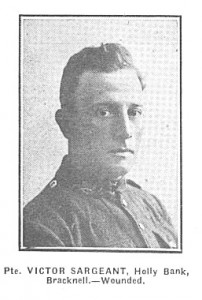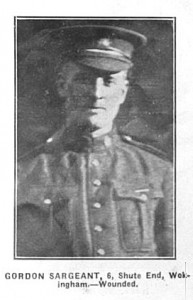Victor Sargeant. Died 2 November 1918
Victor was born in 1887 to father John and mother Martha in Bracknell, Berkshire. He was the ninth born and had thirteen siblings; six brothers and seven sisters. The 1911 census tells us Martha had fourteen births and remarkably, they all survived. However, Victor’s story is only a part of this huge family’s experience, before, during and after the war.
When Martha married John, she must have seen potential in a man whose family were manual workers (father John was a wheelwright), but he himself was a solicitor’s clerk (1901). John was to later become a solicitor with his own practice in Wokingham, with a governess for the children and several domestic staff. John was a self made man, a member of Wokingham’s middle class and living in a large Georgian home at Shute End. He was also Registrar and Clerk to the Board of Guardians of the local workhouse by 1903.
The first indicator of how the family had split up at the turn of the new century is when we find John on board the Mauritania and making his way to New York in 1912. We learn that not only his eldest John, has made his way to Canada, but four of the brothers have joined him. Of John’s seven sons, only two, William and the youngest, Donald have decided to stay. However, when duty called to defend the old country, all five of the Canadian sons had answered the call.
We believe John (junior) made several journeys back to England and the ships records tell us he is a sailor. He survived the war. Gordon became a Canadian soldier and was wounded in battle, but he survived too. Victor joined the 46th Battalion of the Canadian Infantry (Saskatchewan Regiment) around 1916 and was soon on his way to France. He was awarded the Military Medal for bravery, but few weeks before the end of the war, on the 2nd November he had was killed around the village of Auberchicourt, northern France. Wilfred was too marry a Canadian girl, Ester Rose Oliver and later became a US citizen. Although Wilfred was called up for duty during the Second World War, he was unlikely to have seen action on account of his age. Robert was to join The Royal Garrison Artillery, but was to be wounded during an action in 1915 and died at home with his family. Father John was to die soon after the war in 1920 and in 1923 his wife was visit her sons in Canada, but was to return home to her children in England. Even after a life of birthing and rearing fourteen children, Martha passed away at the veritable age of 82 in 1937. What a life !
An article in the Reading Chronicle on 23rd November 1918 tells us a little more about the family;
” Mr and Mrs J F Sargeant have to mourn the loss of another son Victor who belonged to a canadian regiment. One of 7 brothers who volunteered, 5 accepted for service and Victor the second son to give his life.
Severely wounded at Vimy Ridge and sent to England to convalesce he spent time at Bearwood and returned to France last April. 2 daughters of Mr and Mrs Sargeant were among the first lady carpenters to go to France and worked at Calais for upwards of 12 months”
Name: SARGEANT, VICTOR
Initials: V
Nationality: Canadian
Rank: Private
Regiment/Service: Canadian Infantry (Saskatchewan Regiment)
Unit Text: 46th Bn.
Age: 31
Date of Death: 02/11/1918
Service No: 886564
Awards: M M
Additional information: Son of John F. Sargeant and Mrs. M. S. Sargeant, of The Shack, Wokingham, Berks, England.
Casualty Type: Commonwealth War Dead
Grave/Memorial Reference: I. B. 3.
Cemetery: AUBERCHICOURT BRITISH CEMETERY
Historical Information: The village was occupied by Commonwealth troops in October 1918. The cemetery was begun at the end of that month and used until February 1919 while the 6th, 23rd and 1st Canadian Casualty Clearing Stations were in the neighbourhood. These original graves are in Plot I, but the cemetery was enlarged after the Armistice when graves (mainly of 1918-19, but also of August 1914) were brought in from the surrounding battlefields and from the following smaller burial grounds. AUBERCHICOURT CHURCHYARD, in which one Canadian soldier was buried in October 1918. LIEU-ST. AMAND BRITISH CEMETERY, at the South-West corner of the village, used by units and Field Ambulances of the 51st and another Division, in October 1918, for the burial of 28 soldiers from the United Kingdom. MONTIGNY BRITISH CEMETERY (Nord, East of Douai), near the South-West angle of the Bois de Montigny. This cemetery, made by the 6th Casualty Clearing Station in November 1918-February 1919, contained the graves of 20 Canadian soldiers, 16 (and one airman) from the United Kingdom, and one of the United States Army. SOMAIN COMMUNAL CEMETERY, in which one R.F.C. officer who fell in 1916, is still buried. The graves of seven Canadian soldiers who fell in October 1918, and one from the United Kingdom buried by the enemy in March 1918, have been removed. WALLERS COMMUNAL CEMETERY EXTENSION, in which nine Canadian soldiers were buried in October 1918. Auberchicourt British Cemetery contains 288 Commonwealth burials and commemorations of the First World War. 19 of the burials are unidentified and special memorials are erected to one soldier from the United Kingdom but there is a special memorial to one casualty known to be buried among them.
The Shack, Oxford Road, Wokingham, Berks, England. Post War.
Holly Bank, Bracknell, Berkshire 1901
6 Shute End, Wokingham, Berkshire (now a church) 1911


